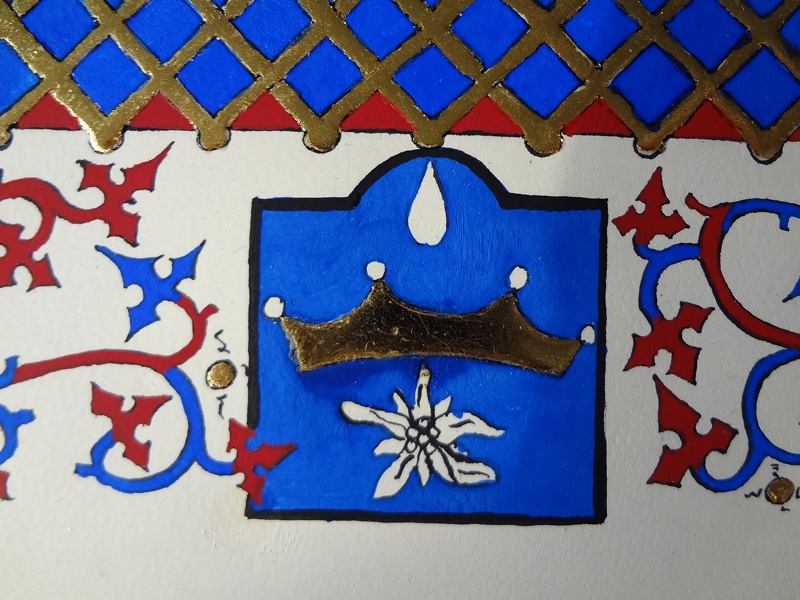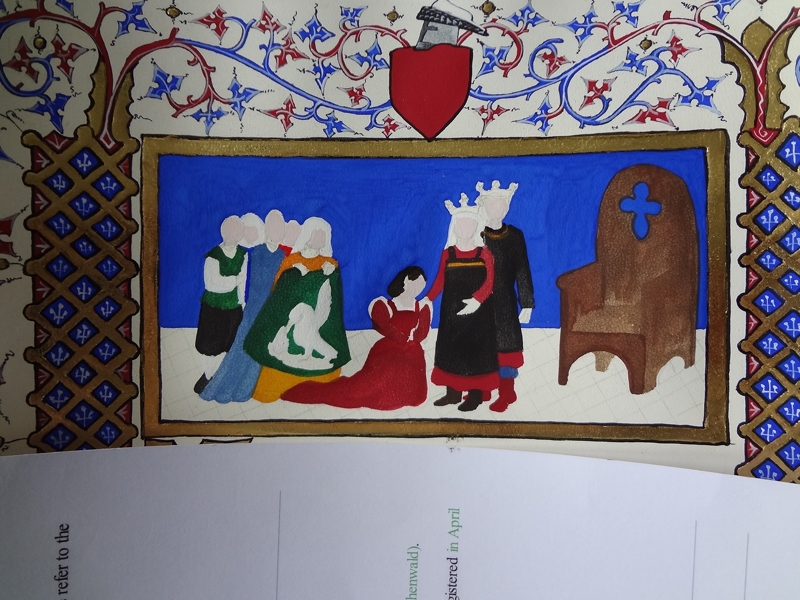The first challenge was finding just the right inspiration and that meant pouring through many images, website and books until this one finally stepped off the page and said hullo to me. I showed it to my husband who asked if I had enough time (3 weeks or so) to finish it and my reply was sure no problem and he laughed. It was a huge project for me which stretched my abilities and of course it took longer than I thought it would but in a good way.
 | |
| Add caption |
Lucky for me I have a really nice drafting table which makes lines easy.
Once the penciling was done the inking begins.Calligraphy is not at all my strong point and I work really really hard at it to get it right. It's also where I most often make mistakes so I did the text first just in case I really screwed it up and had to start from scratch again.
Sometimes I never know how the ink will react so I did two tiny crows in unobtrusive corners as ink tests. There was no major spidering so yay!
The Phew moment when it was completed without any big problems.
Next I had to lay down the gold size but before that I had to make it. This is a mix of gum arabic, brown sugar and water. It needs to sit for a day so while that was happening I began the process of inking and drawing.
Then I tested it on a scrap piece.
The fabulous thing about the modern age is a touch screen tablet and wi-fi allowing me to get right int the piece and see the details that a photo in a book just cannot show you.
Laying down the gold size took 3 days, roughly around 8 hours a day give or take.
Gilding took around 4 days also around 8 hours a day and I used around 5 sheets of double ducat transfer leaf.
Once the gilding is done I can then start the painting. 1st I block all the solid colours, then I start the white work and the outlines. Once that was done I began the last piece which was the miniature.
The scroll was done on 11x14 inch goat parchment. Oak-gall/iron ink, brause nibs, H pencil, plastic eraser, gouache and water colours from Schminke, double ducat, 23Kt transfer gold, sugar and gum arabic and water size, paint brushes were sable hair and synthetic hair and ranged from a 2 - 00000. Think that's the specs. It took 3 weeks at working roughly 8 hours / day ( not including weekends but including the time I took for breaks )
















































































Phenomenal work. Passionate attention to detail. Simply gorgeous.
ReplyDeletethank you :)
ReplyDeleteFantastic! And thank you for documenting the process
ReplyDeleteWow! What an amazing piece of work! Thank you so much for all the detailed pictures. It's fabulous to see the full process. I'm curious about the gilding size you used from gum arabic, brown sugar and water. Can you tell us the proportions (or is a trade secret :) Thanks again!
ReplyDeleteNot a trade secret at all. The recipe which came from this book The Gilded Page: The History and Technique of Manuscript Gilding by Kathleen P Whitley is essentially 1 part gum arabic to 1 part sugar ( I use super fine brown) to 4 parts water. using a teaspoon I get enough size to do multiple scrolls it makes a lot. You dissolve the gum in the water and you need to let it sit for around 4 hours to dissolve properly or else you get a lot of bubbles and blobs, gum dissolves fully but slowly, then I add the sugar and allow that to dissolve using a mortar and pestle to very slowly grind out any crunchy bits. Once this is done and I have a nice clear amber coloured liquid I filter it into a clean short jar via a piece of nylon stocking to catch any lumps. You can use this size for flat and raised gilding by layering it over several days allowing each layer to fully dry in between. Depending on how dry or humid your living area is you might need to adjust the ratio of sugar / gum. The sugar creates the stickiness and the gum add elasticity.
ReplyDelete